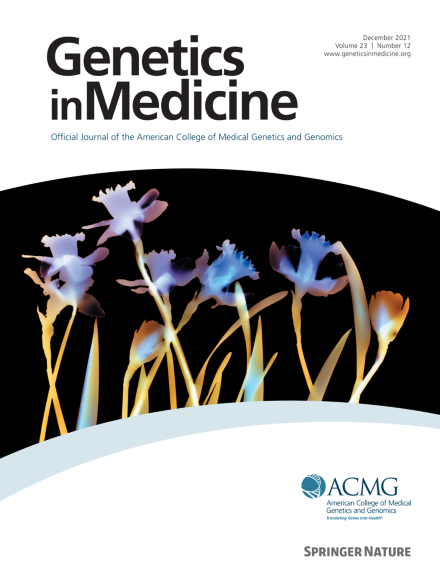由FBN2突变体引起的关节关节闭锁与关节表面细胞的异常和错误分化有关。
IF 6.2
1区 医学
Q1 GENETICS & HEREDITY
引用次数: 0
摘要
目的:研究骨关节炎(OA)的高置信度效应基因FBN2在关节滑膜闭锁(SJ)中的潜在作用,因为已知几个OA相关基因会导致SJ。方法:我们使用来自桡尺关节滑膜闭锁(RUS)的中国汉族参与者的外显子组测序数据分析OA相关基因的变异。根据ACMG/AMP指南对变异进行分类。Fbn2敲除小鼠通过CRISPR/Cas9产生,并通过多个发育阶段的放射学和组织病理学分析进行评估,并辅以细胞和分子研究。结果:我们在不相关的RUS家族中发现了15个罕见的、破坏性的FBN2变异。包括7种可能的致病变异(4种无效变异)。Fbn2敲除小鼠(纯合子和杂合子)均表现出SJ表型。与之前报道的SJ机制涉及失败的带间形成不同,fbn2相关的SJ发生在正常的带间形成之后。突变小鼠关节表面细胞内细胞外基质(ECM)组成和体积发生显著变化。我们认为这些ECM的变化介导了关节表面细胞向成骨细胞的转分化,并最终发育成骨骼。结论:我们发现了导致人类和小鼠SJ的FBN2致病变异。FBN2突变体引起的SJ与关节表面细胞的异常和错分化有关。本文章由计算机程序翻译,如有差异,请以英文原文为准。
Synostosis of joints caused by mutant FBN2 is linked to the abnormalities and misdifferentiation of articular surface cells
Purpose
FBN2, a high-confidence effector gene for osteoarthritis (OA), was investigated for its potential role in synostosis of joints (SJ) because several OA-related genes are known to cause SJ.
Methods
We analyzed variants in OA-related genes using exome sequencing data from Chinese-Han participants with radioulnar synostosis (RUS). Variants were classified following American College of Medical Genetics and Genomics/Association for Molecular Pathology guidelines. Fbn2 knockout mice were generated via CRISPR/Cas9 and evaluated through radiological and histopathological analyses at multiple developmental stages, with complementary cellular and molecular studies.
Results
We identified 15 rare, damaging FBN2 variants in unrelated RUS families, including 7 likely pathogenic variants (4 null variants). Fbn2 knockout mice (both homozygous and heterozygous) exhibited SJ phenotypes. Unlike previously reported SJ mechanisms involving failed interzone formation, Fbn2-related SJ occurred after normal interzone formation. Mutant mice showed significant alterations in extracellular matrix composition and volume within articular surface cells. We proposed that these extracellular matrix changes mediated the transdifferentiation of articular surface cells into osteoblasts, which ultimately developed into bones over time.
Conclusion
We identified FBN2 pathogenic variants that caused SJ in humans and mice. SJ caused by mutant FBN2 is linked to the abnormalities and misdifferentiation of articular surface cells.
求助全文
通过发布文献求助,成功后即可免费获取论文全文。
去求助
来源期刊

Genetics in Medicine
医学-遗传学
CiteScore
15.20
自引率
6.80%
发文量
857
审稿时长
1.3 weeks
期刊介绍:
Genetics in Medicine (GIM) is the official journal of the American College of Medical Genetics and Genomics. The journal''s mission is to enhance the knowledge, understanding, and practice of medical genetics and genomics through publications in clinical and laboratory genetics and genomics, including ethical, legal, and social issues as well as public health.
GIM encourages research that combats racism, includes diverse populations and is written by authors from diverse and underrepresented backgrounds.
 求助内容:
求助内容: 应助结果提醒方式:
应助结果提醒方式:


